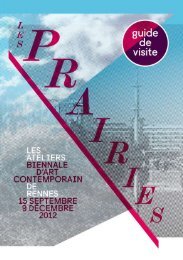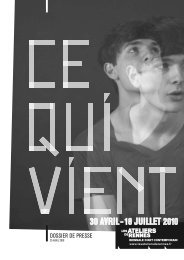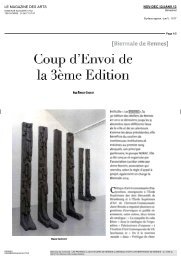Download here the Visitor's guide. - Les Ateliers de Rennes
Download here the Visitor's guide. - Les Ateliers de Rennes
Download here the Visitor's guide. - Les Ateliers de Rennes
Create successful ePaper yourself
Turn your PDF publications into a flip-book with our unique Google optimized e-Paper software.
AGLAIA KONRAD<br />
Concrete & Samples III Carrara, 2010. Courtesy Production Auguste Orts. © Adagp, Paris 2012.<br />
<strong>Les</strong> Prairies's artists<br />
Concrete & Samples I, II et III is a series of films by Aglaia Konrad <strong>de</strong>voted to two structures and a natural<br />
site greatly modified by humans. The first film in <strong>the</strong> trilogy explores <strong>the</strong> Church of <strong>the</strong> Most Holy Trinity<br />
in Vienna. The building was <strong>de</strong>signed by <strong>the</strong> sculptor Fritz Wotruba and looks like a monumental abstract<br />
sculpture. It is a cubist arrangement of a hundred and fifty-two asymmetrically placed concrete blocks.<br />
Concrete & Samples II Blockhaus presents <strong>the</strong> Church of Saint-Berna<strong>de</strong>tte-du-Banlay in Nevers, <strong>de</strong>signed<br />
by Clau<strong>de</strong> Parent and Paul Virilio. It is a monolithic and enigmatic building that from <strong>the</strong> outsi<strong>de</strong> looks like<br />
a <strong>de</strong>fensive bunker in raw concrete. The interior space gets its dynamic from two diagonal slopes. The last<br />
film in <strong>the</strong> trilogy, Concrete & Samples III Carrara was shot in <strong>the</strong> famous marble quarry at Carrara. This<br />
constantly evolving landscape comes across as something sculptural, <strong>de</strong>corated with temporary structures<br />
and references to art history. Though none of <strong>the</strong> three films has a commentary, <strong>the</strong>y all offer a subjective<br />
view of <strong>the</strong>se structures and this site. The camera seems to stand in for <strong>the</strong> gaze of a visitor, in this case,<br />
<strong>the</strong> artist's. It is t<strong>here</strong>fore from her point of view, literally and metaphorically, that we discover <strong>the</strong>se places,<br />
and her point of view that gives unity to <strong>the</strong> three films. Aglaia Konrad has chosen to bring <strong>the</strong> three sites<br />
toge<strong>the</strong>r in one series – two mo<strong>de</strong>rn structures in raw concrete and <strong>the</strong> natural place of extraction of a noble<br />
and traditional material for sculpture – and she has tereated <strong>the</strong>m as sculptures in <strong>the</strong>ir own right.<br />
A. L. tr. J. H.<br />
Born in 1960 in Salzbourg (Austria), lives and works in Brussels (Belgium).<br />
retrouvez cette artiste à 40mcube<br />
55






